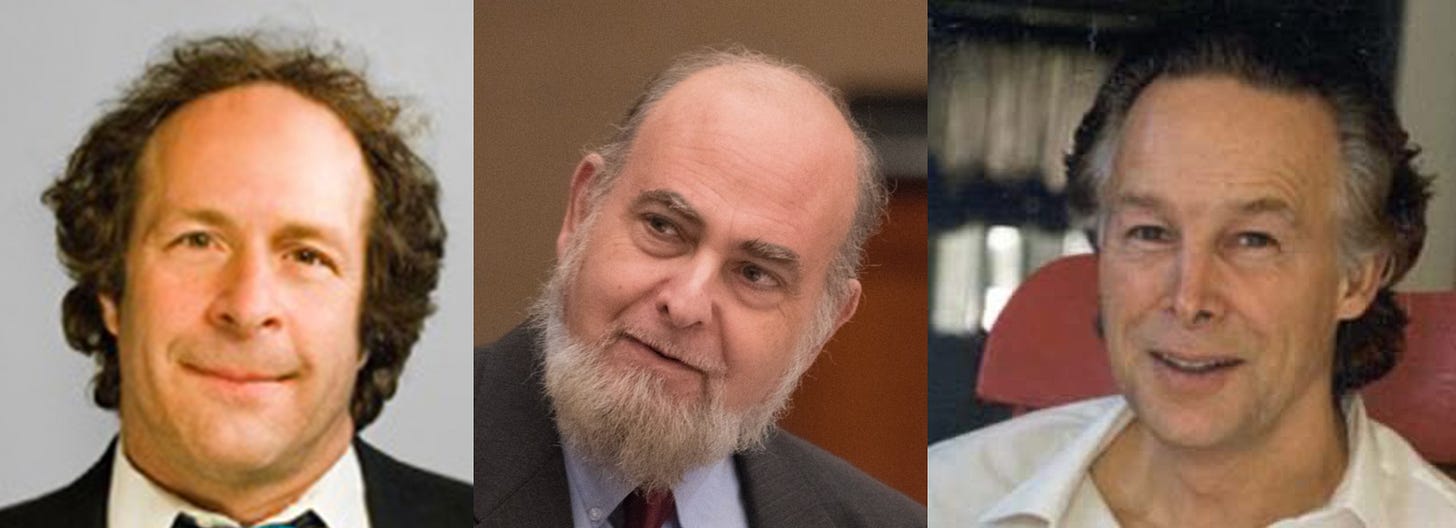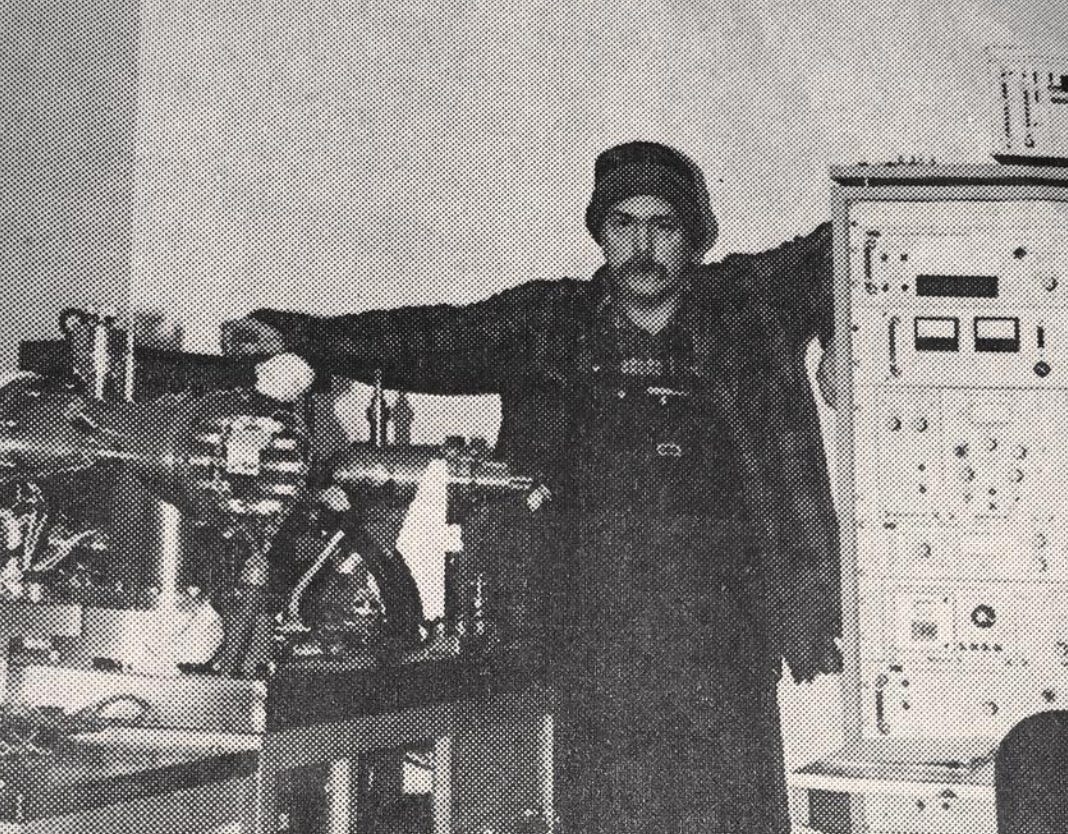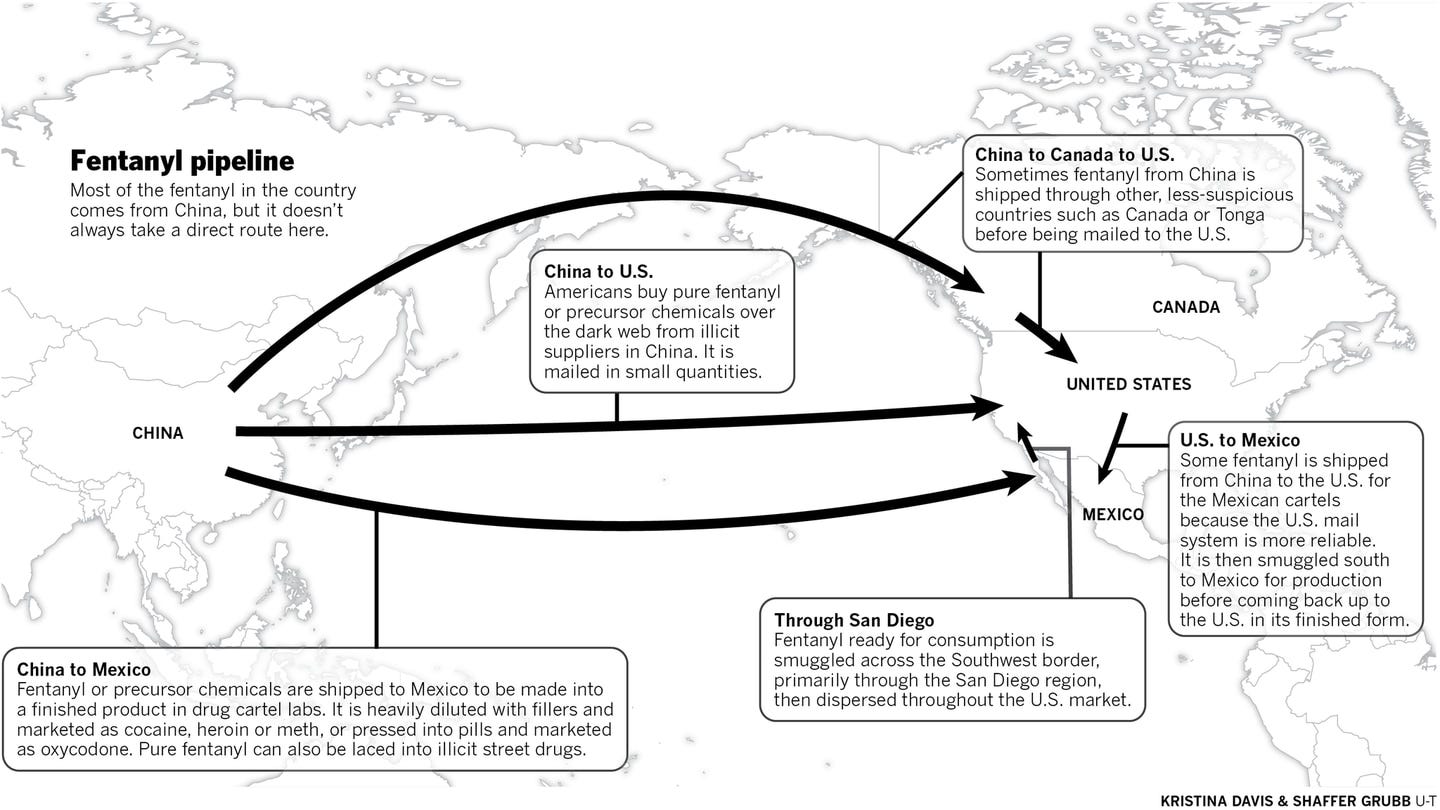What's the deal with neo-Nazis and fentanyl? (Part 2)
Neo-Nazi chemist George Marquardt played a key role in fentanyl's popularization
[This is the 2nd part of a 2-part piece about neo-Nazis and fentanyl. Read Part 1 here.]
We left off at the end of Part 1 with Alexander Shulgin’s 1975 prediction about fentanyl’s potential use as a street drug. Just four years later, in 1979, the first reports emerged of fentanyl on the street.1
And in the mid-1980s, clandestine production of industrial quantities of a fentanyl analog (3-methylfentanyl) was discovered at the US Naval Research Laboratory in Washington, DC as well as at a DuPont Corporation laboratory in Delaware. In both cases, chemists were arrested.2
Pickard’s Harvard fentanyl project
You may also remember the name William Leonard Pickard, a chemist mentioned toward the end of Part 1. Pickard is central to the story of fentanyl because, like his mentor Shulgin, Pickard also warned—quite vocally—about the potential which fentanyl held as a worldwide replacement for opium-derived heroin.3 He did this largely through his work at Harvard University’s Kennedy School of Government.
Pickard entered the Kennedy School master’s program in September 1994. He had received help with his enrollment from Mark Kleiman, a former Justice Department official who taught at the Kennedy School and “had an inside track with admissions.”4 Kleiman advised Pickard during his time in the program, as he had for Rick Doblin, who himself had graduated from the Kennedy School in 1990.5
At Harvard, Pickard worked on a project intimately connected to the global opioid industry. Kleiman advised Pickard to focus on the politics of the international drug trade—or, in the words of journalist Dennis McDougal, “drug diplomacy.”6 Pickard set his attention on Russia’s illicit opioid industry, leading him ultimately to fentanyl.7
Around roughly the same time that Pickard turned his attention toward fentanyl, the drug was approved for prescription use by the FDA in 1994 as a pain medication for children.8 Like his teacher Shulgin, Pickard recognized that fentanyl had the potential to emerge as a popular substitute for heroin.9 In Russia, apparently, it already had.
While at Harvard, Pickard acquired contacts in the CIA and the State Department. The CIA has always been close with Harvard and particularly with the Kennedy School. As Daniel Golden demonstrates in Spy Schools: How the CIA, FBI, and Foreign Intelligence Secretly Exploit America's Universities, a number of CIA officers have participated in the Kennedy School master’s program over the years and the school has long maintained a working relationship with the agency. Golden describes Harvard as “a training ground for [CIA] employees.”10
Pickard’s CIA and State Department contacts introduced him to several high-level Russian officials. Pickard spoke with Russian drug enforcement officials, a government-employed chemist, and recorded conversations with the head of Russia’s Ministry of Internal Affairs—all purportedly as part of his work at Harvard.11 He also corresponded with chemists who had developed fentanyl synthesis techniques.12
Enter George Marquardt
One of them was George Maquardt. And it is through Marquardt that the Nazi/neo-Nazi theme emerges quite clearly in the story of fentanyl. Marquardt had been a child prodigy in chemistry. And he stuck with chemistry his whole life.13 Growing up, Marquardt’s heroes were a pair of German chemists from the nineteenth century. He was also intensely interested in Nazism and is said to have looked up to Adolph Hitler since his childhood.14
And Marquardt got into drug synthesis quite early on. He reportedly made his first batches of heroin and LSD as a teenager.15 Soon, he moved on to other psychoactive substances. According to Newsweek, Marquardt “was the only US source of illegal fentanyl” by the early 1990s.
McDougal wrote that Marquardt “had zero pity” for people who used his fentanyl and saw his relationship with them as purely transactional. Marquardt’s ex-wife Peggy Dulaney told McDougal that he “got off on the power trip of being able to make drugs and [see] what people would do to get them.”16 Yet Marquardt apparently spent more time with law enforcement personnel than he did with outlaws, even befriending narcs at times.
By 1993, Marquardt would be connected to well over 100 of the earliest fentanyl overdoses on record. One of them occurred in the summer of 1992. It happened to someone named Joseph Martier. Martier was a former Exxon chemist who’d left the petroleum business to manufacture industrial quantities of PCP which was distributed by a Pennsylvania biker gang. And in August 1992, he was admitted to a hospital on the cusp of death from a fentanyl overdose. He managed to survive, but his situation puzzled the medics who tended to him. None of them had ever seen a fentanyl overdose before.
Within a few months, the fentanyl that nearly killed Martier was traced to Marquardt’s home lab. He was arrested in early 1993, but—curiously—his fentanyl lab was left in place.17
Pickard + Marquardt
With express permission from Kleiman and Harvard, Pickard reached out to Marquardt in March 1995. Marquardt was in prison by then, but Pickard wrote a series of letters in which he asked Marquardt about fentanyl, its chemistry, the precursors used to make it, and various aspects of its global distribution.18 Marquardt happily responded to Pickard’s inquiries.
Pickard was well aware of Marquardt’s love of Nazism. And although Pickard insists that he himself abhors the ideology, he nonetheless decided to share the following picture (a high school yearbook photo of the young Pickard) with McDougal for publication in Operation White Rabbit:
Interestingly, Pickard told McDougal that his uncle had been one of the first US military personnel to enter the concentration camps at the end of World War 2.19 As readers may recall, that was the precise context in which the US learned about Nazi research into psychoactive drugs such as mescaline. Although I have not yet found any evidence that Pickard’s uncle was in any way involved with that particular discovery, I cannot help but wonder…
Pickard’s intense focus on fentanyl continued after his graduation in 1997.20 That year, Mark Kleiman left Harvard and joined the Drug Policy Analysis Program at the University of California, Los Angeles (UCLA). He invited Pickard to join him. At UCLA, Pickard designed a project he dubbed the Future and Emerging Drugs Study, or FEDS. Through it, he continued his studies of fentanyl. He also used the FEDS program to launder profits from his LSD sales, via large donations made under false names to the program.21
Gordon Todd Skinner’s disturbing fentanyl experiments
In the same period, Pickard’s colleague Gordon Todd Skinner started to dabble with fentanyl in a series of morbidly abusive experiments of his own. Skinner would intentionally overdose innocent victims on fentanyl (and other opioids) and then revive them with Narcan, apparently just for the sheer rush of having total control over others people’s lives.22 But were there other motives at play in these grim experiments?
One of Skinner’s overdose victims was Michael Bauer. A New Mexico-based doctor with CIA connections, Bauer spent quite a bit of time with Skinner and Pickard. Pickard reportedly hired Bauer to help him with his research into the global drug trade. Bauer enthusiastically agreed. But his relationship with Pickard and Skinner took a dark turn.
He was one of several people that Skinner deliberately overdosed with fentanyl and then saved with Narcan. Another individual who was associated with Skinner, Pickard, and Bauer in this period compared Skinner’s fentanyl freak-outs with the gruesome experiments of the Nazi doctor Josef Mengele.23
After the legendary Kansas silo bust, Skinner reportedly told his DEA handler Karl Nichols that “a white supremacist threatened his mother after reading about the Pickard case.”24 Meanwhile, Pickard testified in court that Skinner had claimed to still possess of some of Marquardt’s lab equipment and precursor chemicals.25 Had Skinner and Pickard made the fentanyl used in Skinner's abusive experiments themselves? And why were white supremacists concerned with Pickard’s case?
The China connection
As mentioned above, Pickard graduated from Harvard’s Kennedy School in 1997. And as Golden explains in Spy Schools, the Kennedy School—whose alumni include some stunningly powerful people across the world—has long been a favorite spot for Chinese government operatives to gather intel.26 Might there have been Chinese intelligence assets present when Rick Doblin and William Pickard were studying and discussing MDMA and fentanyl in the corridors of Harvard?
Although I have no explicit evidence that Chinese intelligence gathered information directly from Doblin or Pickard in this period, I nonetheless find it fascinating that Chinese drug trafficking organizations (DTOs) who had by then developed tight relationships with the Chinese Communist Party (CCP) began distributing MDMA and fentanyl within a few years of Doblin and Pickard’s respective graduations from the Kennedy School.
Governments have long used confidential informants in and around the drug trade to gather sensitive information. Are the rise of MDMA and fentanyl around the turn of the millennium the result of such drug trade espionage? Ironically, Pickard may have precipitated the very phenomenon he claimed to predict.
While all of this was going on, CCP-affiliated DTOs had started to infiltrate Vancouver, Canada. Known collectively as the Triads and with a long and complex history going back centuries, these gangs flaunted political connections to the highest levels of the Chinese government. With their help, Vancouver would soon become an epicenter of fentanyl production, distribution, and consumption.27
By the early 2000s, Mexican cartels began working with Chinese DTOs too. With this, the stage was set for an explosion in fentanyl production and consumption. Precursors made in China were (and still are) shipped to Mexico and Canada where they are then prepared as fentanyl pills and distributed across the continent. Consumption has so far been concentrated in the US and Canada although rates of use are increasing in Mexico and elsewhere. As noted above, fentanyl has also appeared sporadically in Russia for years.
There even exists the possibility that Pickard and Skinner may have themselves been affiliated with an Asian drug syndicate. Karl Nichols, one of the DEA agents who oversaw Skinner (and who had been given the authority to do so by US Attorney Robert S. Mueller III) at one point suspected Pickard’s associates of laundering drug money “from the Golden Triangle.”28 Further, Pickard, Skinner, and their colleagues regularly laundered their drug proceeds through casinos, a strategy which has long been a favored technique among the Triads.
Before we conclude, let’s take a look at some recent cases of neo-Nazis distributing fentanyl and other drugs to bring our story full-circle.
Recent cases of neo-Nazi drug trafficking
We have already reviewed the original Nazi party’s fervent interest in drugs, and we also saw that one of the first street fentanyl chemists was himself ideologically aligned with Nazism and adored Hitler. So perhaps by now it is no surprise that a number of modern neo-Nazi groups have been involved in the trafficking of fentanyl, heroin, and other drugs.
Here are some recent examples:
December 2019: several members of a neo-Nazi terrorist group active on the East Coast began making plans to produce DMT. Evidently, they started the process, but did not get far with it. The following month, they were arrested by the FBI and charged with several other, gun-related crimes.
December 2020: In Austria, authorities arrested “five men aged 21 to 53 with links to neo-Nazi groups.” The group allegedly sold drugs to raise money for weapons.
March 2021: In Germany, police arrested “eight people aged between 24 and 55” and seized heroin, methamphetamine, weapons, “large amounts of cash,” and Nazi memorabilia. The individuals were alleged to have belonged to multiple different neo-Nazi groups that were engaged in “large-scale drug trafficking” and money laundering to support themselves.
February 2022: In the US, three white supremacists plead guilty to accusations that they had planned to attack power grids. It was also revealed that one of the individuals involved had provided the other two with “suicide necklaces” which had been “filled with fentanyl” that they could consume “if and when the defendants were caught by law enforcement.” When they did in fact get arrested, one of them swallowed the pill but survived, according to a press release from the Department of Justice.
January 2023: Sixty-nine people were convicted of involvement in a vast methamphetamine distribution ring run by the Universal Aryan Brotherhood (UAB) in the Oklahoma prison system. The case involved a seizure of over 300 pounds of meth, dozens of guns, and nearly half a million dollars in drug proceeds.
January 2023: In California, notable volumes of fentanyl, heroin, methamphetamine, and ketamine seized from a “white supremacist crime ring” in a series of SWAT raids.
With the exception of DMT, every single one of the drugs listed above is produced and/or distributed by CCP-affiliated Triads with connections in Canada and Mexico. Is it possible that the neo-Nazi gangs that sell these drugs get their supply—whether in part or in whole—from the Triads? It seems quite likely.
Consider the last case, from California in January. It involved fentanyl, heroin, meth, and ketamine. This particular combination of substances is precisely the same cocktail that props of Myanmar’s military junta and the DTOs that collaborate with it. The only drug missing from the mix is ecstasy, another Golden Triangle staple since the turn of the millennium.
We can see quite clearly that the 2021 arrest of neo-Nazi Teddy Von Nukem for fentanyl trafficking is unfortunately nothing unique. Neo-Nazi groups have an extensive and thoroughly documented history of engaging in drug trafficking, particularly opioids and amphetamines.
Considering the extent to which the original Nazi party loved a good buzz—and their morbid interest in using drugs for social control—we can safely say that the theme of neo-Nazi drug trafficking is itself part of a historical continuum that goes back to World War 2 and arguably further.
And we got from point A to point B thanks largely to the work of Paul Janssen (a corporate pharmaceutical chemist who created fentanyl), George Marquardt (a neo-Nazi clandestine chemist who popularized it), and William Leonard Pickard (a CIA-affiliated chemist with a deep interest in fentanyl). Their darling opioid was propelled into the spotlight by Chinese DTOs, who, with their colleagues in the Golden Triangle, continue to dominate the illicit fentanyl trade to this day.
So, that’s what’s up with neo-Nazis and fentanyl.
Thanks for reading.
Bryce Pardo, Jirka Taylor, Jonathan P. Caulkins, Beau Kilmer, Peter Teuter, Bradley D. Stein, The Future of Fentanyl and Other Synthetic Opioids, p. 52.
Ibid., 54
Pickard holds a deep understanding of the chemistry and mechanics of worldwide drug synthesis and distribution. He is widely known to be one of the most prolific LSD chemists alive today (although he publicly denies this for legal reasons). Acid has often been said to represent the introduction of the industrial revolution to the study of naturally-occurring tryptamines. Fentanyl then, in very much the same way, represents the application of industrial revolution principles to the study and production of opioids.
Dennis McDougal, Operation White Rabbit: LSD, the DEA, and the Fate of the Acid King, p. 102-103
Vincent Rado, we’re here, we’re high: essays on drugs, p. 129
McDougal, 102
Interestingly, around the same time he started the Kennedy School program, Pickard was also awarded “a neurobiology research fellowship in the addictions division of Harvard Medical School” (McDougal, 103)
Richard DeGrandpre, The Cult of Pharmacology: How America Became the World’s Most Troubled Drug Culture, p. 31
McDougal, 104
Daniel Golden, Spy Schools: How the CIA, FBI, and Foreign Intelligence Secretly Exploit America's Universities, p. 213-214
McDougal, 152
Ibid., 118, 122
In his younger years, Marquardt had spent some time at the Argonne Research Laboratory in Chicago, as Pickard also had in his youth.
McDougal, 115
McDougal, 116
Ibid., p. 113-119
Ibid.
Ibid.
See ibid., p. 104, and Krystle Cole, Lysergic, p. 145
McDougal, 157-159, 167
McDougal, 180
Ibid., 182. Bauer died in June 2017, reportedly by suicide. According to McDougal, in addition to his CIA connections he had at one point been held for an extended period by the DEA in San Francisco (quite possibly at the same office that a young Pickard visited in 1973). Bauer’s mother is “convinced that there is far more to Mike’s passing than simple suicide” and insists that her son was a victim of some sort of nefarious activity conducted by Pickard and Skinner. Just a month before Bauer’s alleged suicide, another close affiliate of Pickard and Skinner was found dead in their apartment; see McDougal, 295-297).
Ibid., 244
Ibid., 259
Golden, 106
Sam Cooper, Wilful Blindness: How a Criminal Network of Narcos, Tycoons, and Chinese Communist Party Agents Infiltrated the West.
Golden Triangle quote from McDougal, 219; Mueller connection from ibid., 235











